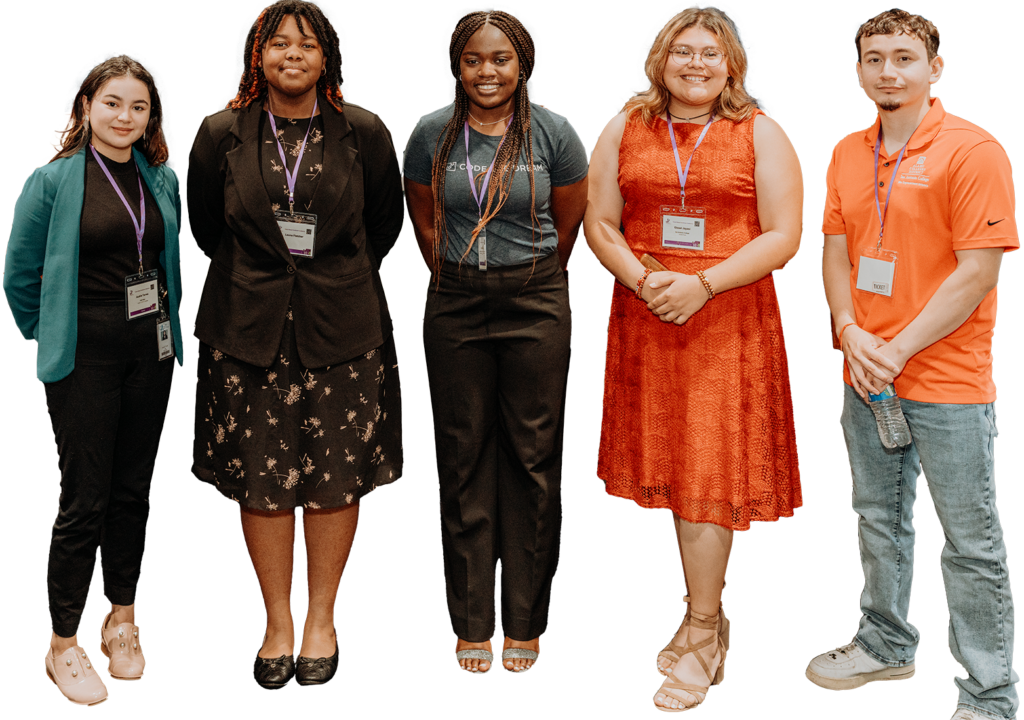Transforming Tomorrow:
Fund Youth Today!

SPEAK UP FOR YOUTH
Policy Recommendation:
Allocate 20% of the City of San Antonio’s annual revenue growth to support initiatives for young residents aged 0-24, potentially generating $65 million.
Youth Challenges:
Highlight significant gaps in support for young people, with many facing poverty, academic challenges, absenteeism, drug issues, and mental health needs.
Budget Gap:
Emphasize the importance of funding for youth, who make up 35% of the population but receive only 6% of the city’s general fund budget.
Public Support:
Majority support from voters and youth for the proposed funding set-aside, with priorities on supporting at-risk youth, preventing child abuse, and enhancing youth mental health services.
Expanding the Commission’s Talent Agenda to include San Antonio Families
Policy Recommendation

Meeting the Persistent Need
In 2021, following the completion of a comprehensive fiscal map, UP Partnership organized a Strategic Funding Task Force composed of representatives from over 60 organizations, including youth leaders, who serve young people and families from all city council districts. Their diligent efforts revealed major gaps in necessary support for young people across the cradle to career spectrum.
In every council district in San Antonio there are young people with persistent and overwhelming needs, which is why according to the most recent Status of Poverty report, the under 18 age range accounts for more than half of our residents living in poverty. Available data makes clear that young San Antonians across our community struggle with not just academics, but also linked challenges like chronic absenteeism, drug poisoning, and mental health challenges needing medical support. This is why we can no longer let children and youth be under-resourced. With this dedicated stream of revenue, City Council would be able to reflexively direct more investments to programs that meet their communities’ needs as they emerge and shift over time.
These new investments can stand on the shoulders of the city’s current investments that support impactful programs. For example, the NxT Level program started by the Department of Human Services is actively changing the lives and trajectories of young people who have become disconnected from school or work, AlamoPROMISE is dramatically expanding pathways to a postsecondary credential, and dozens of out-of-school time providers are helping to improve student promotion to the next grade. In a recent study of 14,978 students who took part in afterschool programming in our community, 94% were promoted to the next grade level, compared to 85% of all ISD students in school districts that shared their data. Efforts like these demonstrate the availability of proven programs that are ready to benefit more young people – efforts that can be complemented or scaled to reach more children and youth.
Justification for Set-Aside
Implications for Talent
Distinction from Appropriation
Why Act Now
SPEAK UP FOR YOUTH
Public Attitudes towards funding Youth Programs
Young San Antonians account for 35% of our city, but funding directed toward youth represented only 6% of the City’s General Fund budget in both 2019 and 2024. Throughout May 2024, we conducted a citywide survey to gauge the support to further fund youth programs in San Antonio via email, text and telephone interviews in both English and Spanish. The citywide survey was made in partnership with FM3 Research.
- 806 total interviews
- 100 youth surveyed
- 706 adult voters
- English & Spanish surveys
Gauging Community Support
Voter Sample
No Data Found
No Data Found
Total Support: 49%
Total Oppose: 46%
Youth Sample
No Data Found
No Data Found
Total Support: 74%
Total Oppose: 20%
Voter Sample
No Data Found
No Data Found
Total Support: 76%
Total Oppose: 22%
Youth Sample
No Data Found
No Data Found
Total Support: 75%
Total Oppose: 12%
Proposed City Charter Amendments
By August 2024, based on recommendations from the City’s Charter Review Commission, these amendments could make some changes to improve outcomes in our community.
Change Ethics Procedures
Increase City Compensation
More City Districting
Increase the number of City Council Districts to account for the City’s growing population
Update Term Limits
Where do locals want more support?
Messages describing children as the future of San Antonio and noting that this measure will keep kids out of trouble resonated strongly.
Voter support still remained strong after an exchange of pro and con messaging around the efforts to increase youth funding in our community.
Measuring Opposition to the Set-Aside
Government Waste
Unbalanced Budget Cuts
Parental Duties
Conclusions
- Both voters and young San Antonio residents have a positive opinion of City government.
- Voters are initially divided on a proposed package of technical charter amendments, but widely supportive of the proposed amendment setting aside funding youth and children’s programs.
- San Antonio 17- and 18-year-olds are broadly supportive of both the comprehensive package of amendments and the set-aside.
- Voters place the greatest priority on using funds to support at-risk youth, such as those experiencing homelessness and in foster care, prevent child abuse, and support youth mental health.
- Support for the proposed set-aside is durable after an exchange of pro and con messaging.
- Positive messages resonate very strongly among the electorate; the most convincing describe the importance of investing in the future, keeping young people out of trouble, the critical development that happens before age five, supporting youth experiencing homelessness, and providing job training opportunities.
- Overall, the findings reflect widespread support and interest in the set-aside, both among the electorate in general and among 17-18 year olds.